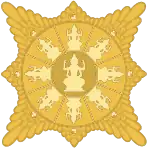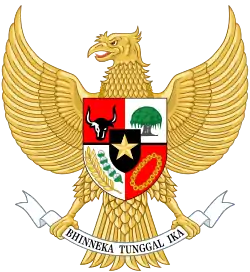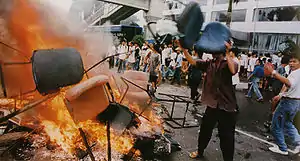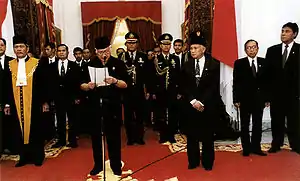Fall of Suharto
Suharto resigned as president of Indonesia on 21 May 1998 following the collapse of support for his three-decade-long presidency. The resignation followed severe economic and political crises over the previous six to twelve months. Vice president B. J. Habibie took over the presidency.
Part of a series on the |
|---|
| History of Indonesia |
   |
| Timeline |
|
|
Dissent under the New Order
Coming to power in 1967 on the aftermath of an attempted coup, launched by middle-ranking officers in the Indonesian army and air force but officially blamed on the Communist Party of Indonesia (PKI), the government of Suharto adopted policies that severely restricted civil liberties and instituted a system of rule that effectively split power between the Golkar organisation and the military.[1]
In 1970, price rises and corruption prompted student protests and an investigation by a government commission.[2] Suharto responded by banning student protest, forcing the activists underground. Only token prosecution of cases recommended by the commission was pursued. The pattern of co-opting a few of his more powerful opponents while criminalising the rest became a hallmark of Suharto's rule.
In order to maintain a veneer of democracy, Suharto made several electoral reforms. He stood for election before electoral college votes every five years, beginning in 1973. According to his electoral rules, however, only three entities were allowed to participate in the election: two political parties and Golkar. All the previously existing political parties were forced to be part of either the Islamist United Development Party (PPP) or the nationalist Democratic Party of Indonesia (PDI). Golkar, being Suharto's primary political vehicle, was officially not a political party. All senior civil servants were obliged to join employee associations linked to Golkar, while senior bureaucrats were banned from joining political parties. In a political compromise with the powerful military, Suharto banned its members from voting in elections but set aside seats in the legislature for their representatives. As a result, he won every election in which he stood in 1978, 1983, 1988, 1993, and 1998.[3][4][5]
This authoritarianism became an issue in the 1980s. On 5 May 1980, a group called the Petition of Fifty (Petisi 50) demanded greater political freedoms and accused Suharto of misinterpreting the Pancasila state ideology. It was signed by former military men, politicians, academics and students. The Indonesian media suppressed the news, and the government placed restrictions on the signatories, some of whom were later jailed.[6]
Following the end to the Cold War, western concern over communism waned, and Suharto's human rights record came under greater international scrutiny. In 1991, the murder of East Timorese civilians in a Dili cemetery, also known as the "Santa Cruz Massacre", caused US attention to focus on its military relations with the Suharto regime and the question of Indonesia's occupation of East Timor. In 1992, this attention resulted in the Congress of the United States passing limitations on IMET assistance to the Indonesian military, over the objections of President George H.W. Bush. In 1993, under President Bill Clinton, the US delegation to the United Nations Human Rights Commission helped pass a resolution expressing deep concern over Indonesian human rights violations in East Timor.
Cracks emerge
In 1996, the Indonesian Democratic Party (PDI), a legal party that had been used by the New Order as a benign prop for the New Order's electoral system, began to assert its independence under Megawati Sukarnoputri, the daughter of Indonesia's founding father, Sukarno. In response, Suharto attempted to foster a split over the leadership of the PDI, backing a co-opted faction loyal to deputy speaker of Parliament Suryadi against supporters of Megawati.[7]
After the Suryadi faction announced a party congress to sack Megawati would be held in Medan on 20–22 June, Megawati proclaimed that her supporters would hold demonstrations in protest. The Suryadi faction went through with the sacking, and the demonstrations manifested themselves throughout Indonesia. Megawati's supporters then took over the PDI headquarters in Jakarta. On Saturday 27 July, a mob including soldiers in civilian clothing and thugs from the army-associated Pemuda Pancasila organisation forcibly entered the building. According to the National Human Rights Commission (Komnas HAM), five people were killed, 149 injured and 74 missing – mostly from those arrested by the military. The attack was followed by two days of rioting, in which youths burned at least six buildings, including that of the Ministry of Agriculture.[8][7][9]
The political tensions in Jakarta were accompanied by anti-Chinese riots in Situbondo (1996), Tasikmalaya (1996), Banjarmasin (1997), and Makassar (1997); while violent ethnic clashes broke out between the Dayak and Madurese settlers in Central Kalimantan in 1997. After a violent campaign season, Golkar won the rigged May 1997 MPR elections. The new MPR voted unanimously to re-elect Suharto to another five-year term in office in March 1998, upon which he appointed his protégé BJ Habibie as vice-president while stacking the cabinet with his own family and business associates (his daughter Tutut became Minister of Social Affairs). The government's increase of fuel prices by 70% in May triggered rioting in Medan. With Suharto increasingly seen as the source of the country's mounting economic and political crises, prominent political figures, including Muslim politician Amien Rais, spoke out against his presidency, and in January 1998 university students began organising nationwide demonstrations.[10]
Monetary crisis

In the second half of 1997, Indonesia became the country hardest hit by the 1997 Asian financial crisis. The economy suffered a flight of foreign capital leading to the Indonesian rupiah falling from Rp 2,600 per dollar in August 1997 to over Rp 14,800 per dollar by January 1998. The Indonesian companies with US dollar-denominated borrowings struggled to service these debts with their rupiah earnings, and many went bankrupt. Efforts by Bank Indonesia to defend its managed float regime by selling US dollars had little effect on the currency's decline, but instead drained Indonesia's foreign exchange reserves.[12] Weaknesses in the Indonesian economy, including high levels of debt, inadequate financial management systems and crony capitalism, were identified as underlying causes. Volatility in the global financial system and over-liberalisation of international capital markets were also cited.[13] The government responded by floating the currency, requesting International Monetary Fund assistance, closing some banks and postponing major capital projects.
In December 1997, Suharto for the first time did not attend an ASEAN presidents' summit, which was later revealed to be due to a minor stroke, creating speculation about his health and the immediate future of his presidency. In mid-December, as the crisis swept through Indonesia and an estimated $150 billion of capital was being withdrawn from the country, he appeared at a press conference to assure he was in charge and to urge people to trust the government and the collapsing rupiah.[14]
Suharto's attempts to re-instil confidence, such as ordering generals to personally reassure shoppers at markets and an "I Love the Rupiah" campaign, had little effect. Evidence suggested that Suharto's family and associates were being spared the most stringent requirements of the IMF reform process, and there was open conflict between economic technocrats implementing IMF plans and Suharto-related vested interests, further undermining confidence in the economy.[15] The government's unrealistic 1998 budget and Suharto's announcement of Habibie as the next vice president both caused further currency instability.[16] Suharto reluctantly agreed to a wider-reaching IMF package of structural reforms in January 1998 in exchange for $43 billion in liquidity (with a third letter of intent with the IMF being signed in April of that year). However, the rupiah dropped to a sixth of its pre-crisis value, and rumours and panic led to a run on stores and pushed up prices.[16][15]
In January 1998, the government was forced to provide emergency liquidity assistance (BLBI), issue blanket guarantees for bank deposits, and set up the Indonesian Bank Restructuring Agency to take over management of troubled banks in order to prevent the collapse of the financial system. Based on the IMF recommendations, the government increased interest rates to 70% pa in February 1998 to control high inflation caused by the higher prices of imports. However, this action restricted the availability of credit to the corporate sector.[17]

In 1997 and 1998, there were riots in various parts of Indonesia. Sometimes these riots were aimed against Chinese Indonesians. Some riots looked spontaneous, and others looked as if they had been planned. One theory was that pro-Suharto generals were trying to weaken the forces of democracy by increasing the divisions between orthodox and non-orthodox Muslims, between Muslims and Christians and between Chinese and non-Chinese. Another theory was that certain generals were trying to topple Suharto.[18]
Human Rights Watch Asia reported that in the first five weeks of 1998, there were over two dozen demonstrations, price riots, bomb threats, and bombings on Java and that unrest was spreading to other islands.[16] An Islamic school and four mosques were turned ablaze in retaliation for Church fires by Christians.[19]
Trisakti incident
At the start of May 1998, students were holding peaceful demonstrations on university campuses across the country. They were protesting against massive price rises for fuel and energy, and they were demanding that President Suharto should step down.[20][21]
On 12 May, as students at Jakarta's Trisakti University were returning to campus in the late afternoon after demonstrating near the parliament building, men in mobile Police brigade uniforms appeared on the flyover overlooking Trisakti. They shot and killed four students and wounded two more.[22]
Riots of 13–14 May
On 13 and 14 May, rioting across Jakarta destroyed many commercial centres and over a thousand died. Ethnic Chinese were targeted.[23] The riots were allegedly instigated by Indonesian military members who were out of uniform. Homes were attacked and, women were raped by gangs of men who wore ordinary clothing. The US State Department and a government fact-finding team found that "elements of the military had been involved in the riots, some of which were deliberately provoked".[24] However, most of the deaths suffered when Chinese owned supermarkets in Jakarta were targeted for looting from 13–15 May were not Chinese, but Javanese looters who were burnt to death by the hundreds when a fire broke out.[25][26][27][28]
Over a thousand and as many as five thousand people died during these riots in Jakarta and other cities such as Surakarta. Many victims died in burning malls and supermarkets, but some were shot or beaten to death. The riots destroyed thirteen markets, 2,479 shop-houses, 40 malls, 1,604 shops, 45 garages, 383 private offices, nine filling stations, eight public buses and minivans, 1,119 cars, 821 motorcycles, and 1,026 houses.[29]
Allegations of the involvement of the military in planning the riots
In 1998, one of the key generals was Prabowo, son of former Finance Minister Dr. Sumitro Djojohadikusumo. Prabowo had received anti-terror training at Fort Bragg and Fort Benning in the US.[30] In May 1998, Prabowo was the commander of Kostrad, the strategic reserve, the division Suharto commanded when he took power in 1965. One of Prabowo's friends, Muchdi Purwopranjono ran Kopassus (special forces), and another, Syafrie Samsuddin, headed the Jakarta Regional Command.[31] The Indonesian military had been split since the mid-1990s into a "red and white" nationalist faction led by Armed Forces commander General Wiranto and a "green" Islamist faction headed by Prabowo.[32]
A security officer alleged that during the riots, Kopassus (special forces) officers had ordered the burning down of a bank. A taxi driver reported hearing a man in a military helicopter encouraging people on the ground to carry out looting. Shopowners at a plaza claimed that before the riots, military officers tried to extract protection money. A teenager claimed he and thousands of others had been trained as protesters. A street child alleged that Kopassus officers ordered him and his friends to become rioters. There was a report of soldiers being dressed up as students and taking part in the rioting.[33] Eyewitnesses spoke of the destruction being organised, with bands of men with short haircuts directing looters into shops, malls and banks, and of rioters being transported in military trucks. Rape victims testified that ethnic Chinese women were targeted, with assaults planned in advance. Syafrie failed to order his troops to quell the riots, and a report subsequently emerged that Syafrie had actually been in radio contact with the gangs terrorising the city. It is possible that Prabowo hoped the riots would discredit his rival Wiranto and result in Suharto appointing Prabowo to head the armed forces.[34]
In May 1998, thousands of Indonesian citizens were murdered and raped...
The Joint Fact Finding Team established to inquire into the 1998 massacres found that there were serious and systematic human rights violations throughout Jakarta. The Team also found that rioters were encouraged by the absence of security forces, and that the military had played a role in the violence. The Team identified particular officials who should be held to account.
The Special Rapporteur on violence against women... also pointed to evidence suggesting that the riots had been organised (E/CN.4/1999/68/Add.3, para. 45)
Asian Human Rights Commission Press Release[35]
Resignation of Suharto

By the middle of May, there were demonstrations in cities across the country, and students were occupying the parliament building, with no efforts from the authorities to remove them. On 18 May, to the surprise of journalists at a press conference, Suharto loyalists and speaker of the People's Consultative Assembly and People's Representative Council Harmoko called for Suharto's resignation. Meanwhile, Amien Rais, leader of the Islamic organisation Muhammadiyah, declared he would organise a demonstration of a million supporters to call for Suharto's resignation. This was planned for 20 May, celebrated as Indonesia's Indonesian National Awakening. On the evening of 18 May, influential Muslim intellectual Nurcholish Madjid, who had held various meetings with generals and civilians, met with Suharto. The meeting ended with Suharto telling Nurcholish of his intention to resign "as soon as possible" following a meeting with Muslim leaders. This two-hour meeting took place on the morning of 19 May. Afterwards, Suharto announced to the nation that he would reshuffle the cabinet and set up a reform committee to plan new elections.[36][37]
Following a warning from a Prabowo ally of possible bloodshed, Amien Rais called off the demonstration. On 20 May, there was a "massive show of force" from the military, with soldiers and armoured vehicles on the streets of Jakarta. Prabowo wanted a robust response to the demonstrators, but Wiranto realised that the Suharto era was coming to an end and was more receptive to the students' demands. According to sources of the Jakarta Post, Wiranto visited Suharto at home and asked the president to resign. On the same day, some of Suharto's allies refused to serve in a new cabinet. Facing a threat of impeachment from Harmoko, and having received a letter from 14 cabinet members rejecting the formation of a new cabinet, Suharto decided to resign. At 9 am on the morning of 21 May, Suharto made a short speech of resignation. He was immediately replaced by Vice-president B. J. Habibie.[38][39]
Allegedly, late on the evening of 21 May, Prabowo arrived at the presidential palace and demanded that he be made the chief of the armed forces. Reportedly, Habibie escaped from the palace. The following day, Prabowo was sacked as head of Kostrad. Wiranto remained as chief of the armed forces, and his troops began removing the students from the parliament building.[40]
Aftermath
Not so often reported was the silent departure of families and wealth from the country. The emigrants were not exclusively of Chinese descent, but also included wealthy natives (pribumi) and Suharto's cronies. The immediate destination was Singapore, where some stayed permanently while others moved on to Australia, the US and Canada. Many of these families returned when the political situation stabilised a few years later.
Since the fall of the New Order, there has been a variety of state-sponsored initiatives to address the widespread abuses of human rights since the fall of Suharto. A report issued by the International Center for Transitional Justice and the Indonesian Commission for Disappeared Persons and Victims of Violence (KontraS) concluded that, that "senior government officials consistently failed to achieve truth, accountability, institutional reform and reparations for the most severe crimes.[41]
Notes
- Mackie & MacIntyre 1994, pp. 10-13.
- Mackie & MacIntyre 1994, pp. 125-126.
- Friend 2003, p. 35.
- Evans 2003, pp. 24.
- McDonald 1980, p. 20.
- Ricklefs 2008, pp. 483-492.
- Ricklefs 2008, pp. 518-519.
- Friend 2003, pp. 226-230.
- Adidarma & Saptono 1997, p. xiv.
- Elson 2001, p. 267.
- NY Times 1997, p. D6.
- Enoch et al. 2001.
- Aspinall, Klinken & Feith 1999, p. 1.
- Friend 2003, p. 313.
- Aspinall, Klinken & Feith 1999, p. v.
- Friend 2003, p. 314.
- McDonald 2008.
- van Klinken 1997.
- LA Times 1998.
- Schwarz 1999, p. 610.
- Ricklefs 2008, p. 522.
- Schwarz 1999, pp. 613-614.
- Aspinall, Klinken & Feith 1999.
- US Dept. of State 1999.
- van Klinken 1999.
- van Klinken 1998.
- Horowitz 2013, p. 34.
- Fuller Collins 2002, p. 597.
- Christanto 2014.
- Ball et al. 2002.
- Schwarz 1999, p. 600.
- Schwarz 1999, p. 580.
- Arzia Tivany Wargadiredja 2018.
- Schwarz 1999, pp. 616-617.
- AHRC Press Release 2003.
- Schwarz 1999, pp. 620-626.
- Ricklefs 2008, p. 523.
- Schwarz 1999, pp. 627-633.
- Ricklefs 2008, pp. 523-524.
- Colmey 2001.
- ICTJ 2011.
References
- Adidarma, Gibran; Saptono, Irawan (1997), Jakarta Crackdown, Jakarta: Aliansi Jurnalis Independen, Asian Forum for Human Rights and Development, Institut Studi Arus Informasi, ISBN 974-89934-4-2
- AHRC Press Release (7 April 2003). "Indonesia: Five years after May 1998 rights, those responsible for the atrocities remain at large". Asian Human Rights Commission. Retrieved 10 October 2019.
- Arzia Tivany Wargadiredja (21 May 2018). "Reflections of May '98 Looters, Victims of the New Order's 'Organized Riots'". Vice Media.
- Aspinall, Edward; Mvan Klinken, Geert Arend; Feith, eds. (1999). The Last Days of President Suharto. Monash Asia Institute. ISBN 978-0732611750.
- Ball, Desmond; Bourchier, David; Kammen, Douglas; McDonald, Hamish; Klinken, Gerry Van (2002). "Masters of Terror". yayasanhak.minihub.org. Archived from the original on 16 July 2002.
- Brown, Jason (2000). "The Banyuwangi murders" (Apr-Jun 2000 ed.). Inside Indonesia.
- Christanto, Dicky (12 May 2014). "288 burned alive in a Jakarta mall 16 years ago". The Jakarta Post. Jakarta. Retrieved 10 October 2019.
- Colmey, John (24 June 2001). "Indonesia". Time Magazine. Time, Inc. Retrieved 12 April 2010.
- Elson, Robert E. (2001). Suharto: A Political Biography. Cambridge, United Kingdom: Cambridge University Press. ISBN 0-521-77326-1.
- Enoch, Charles; Baldwin, Barabara; Frécaut, Oliver; Kovanen, Arto (May 2001). "Indonesia: Anatomy of a Banking Crisis Two Years of Living Dangerously 1997-99 - WP/01/52" (PDF). Imf.org. Retrieved 25 April 2017.
- Evans, Kevin Raymond (2003). The History of Political Parties & General Elections in Indonesia. Jakarta: Arise Consultancies. ISBN 979-97445-0-4.
- Friend, Theodore (2003). Indonesian Destinies. The Belknap Press of Harvard University Press. ISBN 0-674-01834-6.
- Fuller Collins, Elizabeth (2002). "Indonesia: A Violent Culture?" (PDF). Asian Survey (July/August 2002 ed.). 42 (4): 582–604. doi:10.1525/as.2002.42.4.582. Archived from the original (PDF) on 13 February 2015.
- Horowitz, Donald L. (2013). Constitutional Change and Democracy in Indonesia. Cambridge University Press. ISBN 9781107027275 – via Google Books.
- ICTJ (29 April 2011). "Derailed: Transitional Justice in Indonesia since the fall of Soeharto". International Center for Transitional Justice. Retrieved 10 October 2019.
- van Klinken, Gerry (1997). "Outbreak of rioting: Tinder-box or conspiracy?" (Apr-Jun 1997 ed.). Inside Indonesia.
- van Klinken, Gerry (25 May 1998). "[Indonesia-L] Digest - The May Riot". Library.ohiou.edu. Archived from the original on 25 March 2017. Retrieved 25 April 2017.
- van Klinken, Gerry (25 September 1999). "Inside Indonesia - Digest 86 - Towards a mapping of 'at risk' groups in Indonesia". Archived from the original on 20 September 2000.CS1 maint: bot: original URL status unknown (link)
- "Christian Mobs in Indonesia Burn 4 Mosques in Revenge". Los Angeles Times. JAKARTA, Indonesia. 1 December 1998.
- Liddle, R. William (1978). "The 1977 Indonesian election and New Order Legitimacy". Southeast Asian Affairs. Yusof Ishak Institute. 1978: 122–138. doi:10.1355/SEAA78K. JSTOR 27908341.
- Liebhold, David (19 October 1998). "That New Black Magic". Content.time.com.
- McDonald, Hamish (1980). Suharto's Indonesia. Jakarta: Fontana/Collins. ISBN 0-00-635721-0.
- McDonald, Hamish (28 January 2008). "No End to Ambition". Sydney Morning Herald.
- Mackie, Jamie; MacIntyre, Andrew (1994). "Politics". In Hill, Hal (ed.). Indonesia's New Order: The Dynamics of Socio-economic Transformation. Allen & Unwin. pp. 1-43. ISBN 1-86373-229-2.
- "Indonesia Floats the Rupiah, And It Drops More Than 6%". The New York Times. 15 August 1997. p. D6. Retrieved 25 September 2009.
- Pike, John (30 August 2013). "Dayak". GlobalSecurity.org. Retrieved 10 October 2019.
- Project Plowshares (November 2002). "ARMED CONFLICTS INDONESIA - KALIMANTAN (1996 - 2003)". Project plowshares. Retrieved 10 October 2019.
- Ricklefs, M.C. (2008) [1981], A History of Modern Indonesia Since c. 1200 (4th ed.), Palgrave MacMillan, ISBN 978-0-230-54686-8
- Schwarz, Adam (1999). A Nation in Waiting: Indonesia's Search for Stability (2nd ed.). Allen & Unwin. ISBN 9781760636913.
- U.S. Department of State (26 February 1999). "Indonesia Country Report on Human Rights Practices for 1998". Federation of American Scientists. Retrieved 9 October 2019.
Further reading
- Tanter, Richard; Ball, Desmond; Klinken, Van Gerry; Bourchier, David; Ham, KPP.; Kammen, Douglas; Klinken, Gerry Van; McDonald, Hamish (2006). Masters of Terror : Indonesia's Military and Violence in East Timor. Lanham: Rowman & Littlefield Publishers. ISBN 978-1-4616-4004-2. OCLC 854977782.
- Chandra, Siddharth and Douglas Kammen. (2002). "Generating Reforms and Reforming Generations: Military Politics in Indonesia’s Transition to Democracy." World Politics, Vol. 55, No. 1.
- Dijk, Kees van. 2001. A country in despair. Indonesia between 1997 and 2000. KITLV Press, Leiden, ISBN 90-6718-160-9
- Kammen, Douglas and Siddharth Chandra (1999). A Tour of Duty: Changing Patterns of Military Politics in Indonesia in the 1990s. Ithaca, NY: Cornell Modern Indonesia Project Publication No. 75.
- Pepinsky, Thomas B. (2009). Economic Crises and the Breakdown of Authoritarian Regimes: Indonesia and Malaysia in Comparative Perspective. Cambridge University Press, ISBN 978-0-521-76793-4
External links
- Megawati
- Hendropriyono
- Volunteer Team for Humanity
- Tesoro, Jose Manuel (26 June 1998). "The Hidden Hand". Asiaweek. Archived from the original on 21 April 2001.